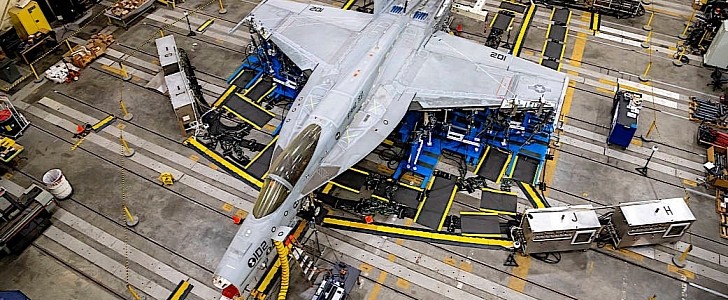Not that visible in the constant releases of the American military as say the F-16 Fighting Falcon, the F/A-18E Super Hornet is too an impressive machine, and it too is at the center of a modernization effort meant to keep in relevant in today’s wars.
As various modifications to the aircraft are being cooked up, engineers expect some changes in the way the aircraft behaves and performs as well. One crucial aspect of this is how it will handle wing loads, and for the task of testing new configurations, the help of NASA’s Armstrong Flight Research Center was enlisted.
For the tests, an F/A-18E Super Hornet belonging to the Naval Air Systems Command (NAVAIR) was shipped to the Armstrong Flight Load Laboratory, where it was subjected to “the center’s biggest load calibrations tests” ever performed.
Three areas were targeted, namely the wings, vertical tails, and horizontal tails. The procedures performed on the horizontal tails concluded in October, and from now until March, NASA will be testing the wings. Testing of the vertical tails is to follow in May.
For the task at hand, NASA uses 84 hydraulic actuators, many of them engaged at the same time. For each test, the actuators will push or pull on the aircraft surface “to put it into tension or compression with a known amount of force.”
“The load cases for this test were designed to reach a maximum of approximately 60% of the airframe allowable limit load,” said one NASA engineer about the procedure. “There are 11 horizontal tail load cases, 62 wing load cases, and 14 vertical tail load cases resulting in a total of 87 test cases.”
NASA expects all the tests to wrap up by the time summer gets here. Once cleared, this exact aircraft will be used as a test vehicle for the proposed upgrades of the F/A-18E Super Hornet fleet.
For the tests, an F/A-18E Super Hornet belonging to the Naval Air Systems Command (NAVAIR) was shipped to the Armstrong Flight Load Laboratory, where it was subjected to “the center’s biggest load calibrations tests” ever performed.
Three areas were targeted, namely the wings, vertical tails, and horizontal tails. The procedures performed on the horizontal tails concluded in October, and from now until March, NASA will be testing the wings. Testing of the vertical tails is to follow in May.
For the task at hand, NASA uses 84 hydraulic actuators, many of them engaged at the same time. For each test, the actuators will push or pull on the aircraft surface “to put it into tension or compression with a known amount of force.”
“The load cases for this test were designed to reach a maximum of approximately 60% of the airframe allowable limit load,” said one NASA engineer about the procedure. “There are 11 horizontal tail load cases, 62 wing load cases, and 14 vertical tail load cases resulting in a total of 87 test cases.”
NASA expects all the tests to wrap up by the time summer gets here. Once cleared, this exact aircraft will be used as a test vehicle for the proposed upgrades of the F/A-18E Super Hornet fleet.






